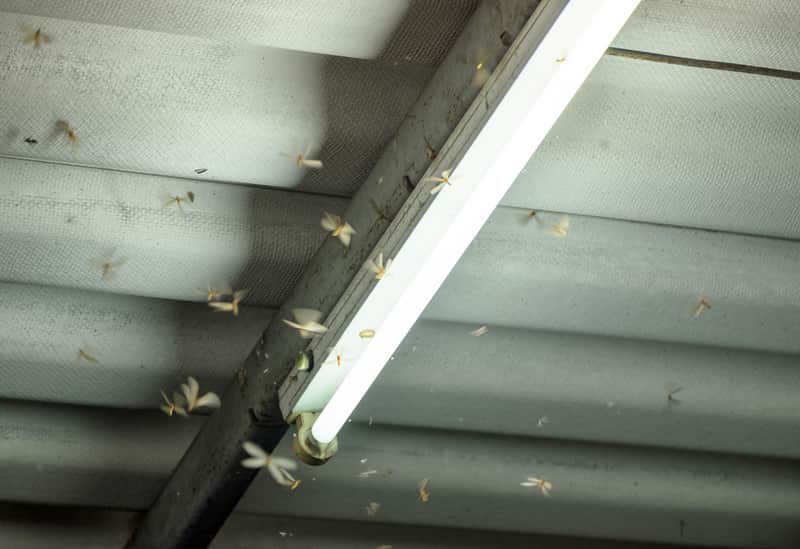During the spring, it’s not unusual to see flying termites after a rain. These swarmers (also known as alates) typically emerge from the ground, tree stumps or cracks in the foundations of homes and buildings. Their job is to depart from the nest, find a mate and establish a new termite colony — one that might eventually be home to thousands or even (in rare cases) millions of offspring.

Termites After Rain
Rain helps make the environment more wet, which in turn makes termite survival more likely since there is plenty of water available.
After a soaking spring or fall rain, thousands of winged reproductives may swarm from the colony seeking to mate and start new colonies. However, the rain is not the trigger for swarming so much as warm temperatures, humidity and the age of the colony itself.
These swarmers don’t fly very well and usually travel no more than about 100 meters from their original colony. Because of this, if you see termite swarmers in or around your house, then they are likely swarming from somewhere nearby. The exception to this are Formosan termites, which are actually fairly good flyers. Once the swarmers land and shed their wings as part of the mating process, a new colony begins when the pair constructs a small underground chamber and the female begins laying eggs.
In reality, very few of the swarmers who fly each year mate and establish new colonies, and very few of the new colonies ever reach maturity, which can take years. Yet, if they survive, the swarmers can be surprisingly long-lived. A termite queen can live to be more than 30 years old.
Types of Termites
While there are many types of termites, the three most commonly found in the U.S. are subterranean, drywood and dampwood termites. All three species need water to survive.
Subterranean termites get their required moisture from the soil. While they normally live in underground colonies, subterranean termites construct mud tubes which they use as passageways to enter homes and forage for food — wood.
Drywood termites typically infest dry, sound wood such as structural lumber, utility poles, decks, fences, stored lumber and fences. They harvest necessary moisture from the wood they’re infesting.
Dampwood termites can usually be found infesting decayed wood that retains moisture either through contact with the ground or exposure to a water leak. Since they usually infest wood that is already damaged and are not all that common, dampwood termites aren't something that homeowners are likely to experience. Dampwood species that are of concern have limited range and are typically only an issue in homes with long-term, high moisture issues. The dampwood termite is the only termite that gets moisture from free water.
Termite Social Structure
Like bees, ants and wasps, termites are eusocial insects who live in elaborately organized colonies, led by a single or few queens. In these colonies, labor is divided, and each class of termite has their own job. The worker termites cooperate in nurturing the young. Upon reaching maturity, this new generation of termites helps support their elders. The soldiers protect the colony. The swarmers (commonly referred to as alates or reproductives) are responsible for reproducing. And the termite queen is responsible for laying eggs.
Sometimes swarmers emerge from inside your home. Luckily, these termites only job is to reproduce and establish new termite colonies. They are incapable of eating wood, seldom survive and can be either swept up or removed with a vacuum cleaner. However, their presence is a strong indication that you may have an existing termite problem.
If you see signs of termites, don't take any chances. Call Terminix® at 1-877-837-6464 and let one of our highly trained termite control professionals conduct a free inspection of your home. If we see evidence of a termite invasion, we’ll present you with a solution to your problem.
Even if you don’t currently have termite activity, it’s a good idea to contact a termite control professional. Since termites feast 24/7, Terminix has plans that can help protect you from the cost of future termite infestations.


